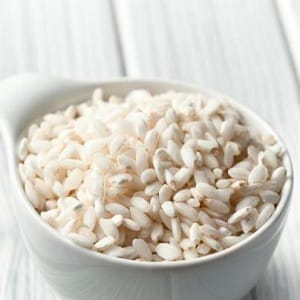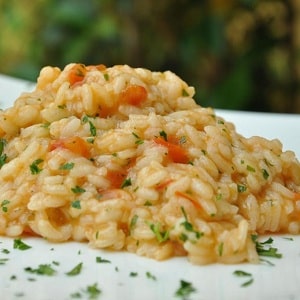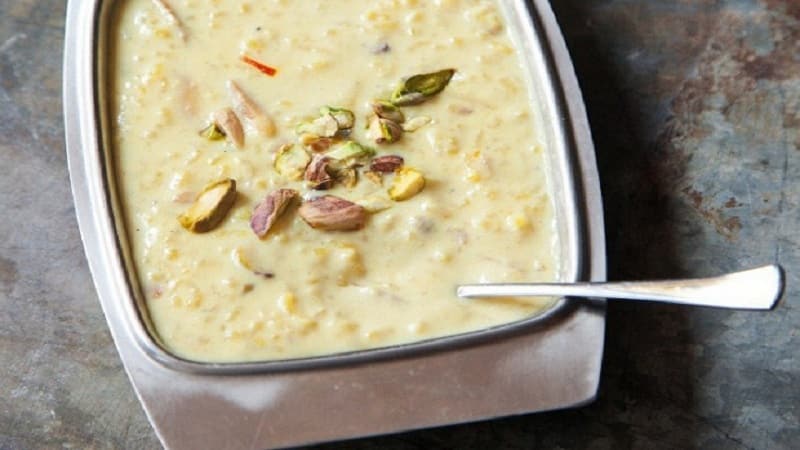What is Arborio rice and what dishes is it used in?
Italian Arborio rice has a translucent surface and contains the carbohydrate amylopectin, an easily digestible food starch. During heat treatment, the top layer of grains becomes sticky and tender, while maintaining its shape. Arborio is the main component of the famous Italian risotto. Thanks to its special structure, rice quickly absorbs water, broth, and the aromas of various spices and seasonings.
In the article we will talk about the features of Arborio, its nutritional value, differences from other varieties rice, we will reveal the secrets of making risotto, delicious arancini balls and orange pudding.
Arborio rice: what is it, features
Arborio is one of the most common rice varieties in Italy. Belongs to the species Oryza sativa (seeding rice). The grains are short, wide, rounded, the surface is pearl-colored. When cooked, they do not stick together due to their moderate starch content.
The culture was developed by Italian rice grower Domenico Marchetti by crossing the Vialone and Lady Wright varieties. Subsequently, other varieties of Italian rice with long and crystalline grains were obtained from them.
The product was named after the small settlement of Arborio in the province of Vercelli, located on the Padan plain. This is an ideal place for growing rice.
In the Po River basin, the air temperature in winter never drops below 0°C and does not rise above +24°C in summer. Abundant rainfall, densely located reservoirs and irrigation canals, and floodplain soils make it possible to grow the best varieties of rice.
Pictured is Arborio rice.

Difference from other varieties
More than 70 varieties of rice are grown in Italy, and Arborio is considered one of the best for making risotto. The grains contain 18-19% amylose, which allows them to maintain their shape and provides high absorption capacity.
Thanks to its structure and size, heat easily penetrates into the outer layer, the core remains intact. The grains perfectly absorb water, wine, broth, increasing fourfold. This is how they differ from other varieties. For example, Basmati only doubles in size when cooked.
Reference. Cooking time for cereal varies depending on the variety, harvest period, aging and degree of processing.
Experienced chefs advise closely monitoring the condition of the grains so as not to overcook them on the stove. It’s easy to cross the line between ordinary boiled rice porridge and exquisite risotto.
Chemical composition
The table shows the vitamin and mineral composition of rice.
| Name | Content | Norm |
| Vitamin B1 | 0.167 mg | 1.5 mg |
| Vitamin B2 | 0.016 mg | 1.8 mg |
| Vitamin B5 | 0.411 mg | 5 mg |
| Vitamin B6 | 0.05 mg | 2 mg |
| Vitamin B9 | 97 mcg | 400 mcg |
| Vitamin PP | 1.835 mg | 20 mg |
| Potassium | 29 mg | 2500 mg |
| Calcium | 3 mg | 1000 mg |
| Magnesium | 13 mg | 400 mg |
| Phosphorus | 37 mg | 800 mg |
| Iron | 1.49 mg | 18 mg |
| Manganese | 0.377 mg | 2 mg |
| Copper | 38 mcg | 1000 mcg |
| Selenium | 7.5 mcg | 55 mcg |
| Zinc | 0.42 mg | 12 mg |
Calorie content and nutrition
Arborio rice contains about 7% protein. By nutritional value the product is superior to wheat. Cereals do not contain gluten, which allows it to be used by people with celiac disease.
Nutritional value of rice per 100 g:
- calorie content - 330 kcal;
- proteins - 2.38 g;
- fats - 0.21 g;
- carbohydrates - 28.29 g.
Use in cooking
Arborio rice is the main component of the famous Italian risotto.The dish is easy to prepare and has a surprisingly delicate taste and creamy texture.
The whole secret is in the cooking technology: the cereal is first lightly fried in olive oil, then vegetable or meat broth is added as the liquid is absorbed. Remove from heat one minute before the rice is ready, leaving the core of the grains firm.
Other dishes are also prepared from cereals:
- sweet puddings, pies and casseroles;
- thick soups;
- arancini - rice balls with various fillings (meat, cheese, vegetables, mushrooms);
- quiche - a savory pie filled with shortcrust pastry;
- paella is a Spanish dish with the addition of meat, vegetables, mushrooms, and seafood, reminiscent of risotto.
Dish recipes
We have prepared for you several recipes for preparing traditional dishes with photographs. There is no need to rinse rice before cooking.
Tomato risotto
Ingredients:
- two medium tomatoes;
- a small bunch of parsley;
- 500 ml vegetable broth or water;
- one shallot bulb;
- 2 tbsp. l. olive oil;
- 160 g Arborio rice;
- salt, pepper to taste.
Preparation:
- Wash the tomatoes, cut into halves, remove the core. Cut the pulp into pieces.
 Wash the parsley, remove the petioles and chop the leaves.
Wash the parsley, remove the petioles and chop the leaves.- Heat the broth.
- In a heavy-bottomed saucepan, sauté diced shallots in olive oil until translucent.
- Add tomatoes to onions and simmer for two minutes.
- Add rice to the pan and mix with tomato sauce. Cook for two minutes.
- Add 4-5 ladles of hot broth and cook for 15-18 minutes.
- Continue adding broth as it is absorbed, stirring the rice occasionally. Do not let the grains completely absorb the liquid or they will cook unevenly.
- Two minutes before the end of the process, add salt, freshly ground black pepper and parsley.
- Stirring constantly, bring the dish until cooked. Turn off the heat and let stand for a minute.
- Serve with fresh parsley.
Traditional Italian risotto with mushrooms
Ingredients:
- 300 g Arborio rice;
- 400 g of fresh forest mushrooms;
- one shallot;
- 1 liter of vegetable broth;
- 50 g grated parmesan;
- butter 82% to taste;
- salt, pepper to taste;
- a pinch of nutmeg;
- 200 ml dry white wine;
- a bunch of fresh parsley;
- 2 tbsp. l. olive oil.

Preparation:
- Wash and peel the mushrooms, cut into slices and drain in a colander.
- Finely chop the parsley.
- Fry the mushrooms in olive oil and throw in a handful of parsley.
- Cut the onion into cubes and fry in a separate bowl in olive oil.
- Add the rice to the onion and cook for 2-3 minutes, stirring gently. The grains should be evenly saturated with oil.
- Pour white wine into the rice, right down the center, then add 3-4 ladles of hot broth, completely covering the rice.
- Cook over low heat and add broth as liquid is absorbed.
- After 15 minutes, add mushrooms, salt, pepper, and a pinch of nutmeg.
- Cook for another three minutes, add grated Parmesan and butter to taste, stir and turn off the heat.
- Serve with fresh parsley.
Risotto with melon
Ingredients:
- 400 g rice;
- one ripe melon;
- 1.5 liters of vegetable broth;
- 80 g butter;
- 100 g white semi-sweet wine;
- one red onion;
- olive oil to taste;
- 1 tbsp. l. 20-30% cream;
- Grana Padano cheese (or any hard cheese).
Preparation:
- Cut the melon pulp into pieces.
- Finely chop the onion and sauté in olive oil.
- Add rice and white wine to the onions.
- Pour in a ladle of broth and add half the melon.
- As the liquid is absorbed, add 1-2 ladlefuls of broth.
- 5 minutes before cooking, add the remaining melon, butter, cream and cheese. Stir, pepper and serve.

Arancini with mozzarella
To prepare the dish, use risotto cooked the day before. Take mozzarella cheese in blocks (marked “for pizza”), easy to melt.
Beat the egg with a pinch of salt. With wet hands, take a small amount of risotto, flatten it into a flatbread, and place a cube of cheese in the center. Then form a ball.
Heat vegetable oil in a deep saucepan. Dip the balls alternately, first in the egg, then in the breadcrumbs. Drop into hot oil and quickly fry until golden, turning with a slotted spoon.
Place the finished arancini on paper napkins to remove excess fat.
Arancini is delicious hot or cold with tomato sauce.

Orange pudding
Ingredients:
- 600 ml milk;
- 500 g Arborio rice;
- 150 g honey;
- 3 tbsp. l. orange zest;
- 70 g pistachios;
- 150 ml cream 20%.
Preparation:
- Remove the zest from the orange.
- Pour milk over the cereal, add zest and honey. Stir and cook over low heat, covered, for 1 hour 20 minutes.
- Pour in the cream, stir and simmer for another 10 minutes.
- Place hot pudding in bowls, sprinkle with chopped pistachios and orange zest. Serve chilled.

How to replace rice
Instead of Arborio, Carnaroli rice is used in cooking. Cereals have the same nutritional value and calorie content, but differ in shape. Arborio is short grain, Carnaroli is medium grain.
The Spanish variety Valencia is reminiscent of Arborio and is suitable for making risotto.
Any white medium-grain or long-grain rice with a high starch content will work as a substitute. But remember that other varieties of grains absorb half as much water as Arborio.
It is better to add cereals with a high gluten content to puddings - for example, Krasnodar round grain.
Reference. Using other varieties, you can only prepare delicious rice porridge, vaguely reminiscent of real risotto with a creamy structure.
Contraindications
Eating rice in large quantities causes constipation and intestinal colic. Children under three years of age are given cereal no more than once a week.
If you have an allergy, you should completely exclude the product from the menu. Nutritionists recommend limiting cereal consumption when losing weight.
Read also:
Can an allergy to rice occur and how does it manifest itself?
Is it possible to eat rice with gastritis: arguments for and against, choice of variety.
Conclusion
Arborio rice contains a large amount of vitamins and minerals, easily digestible starches and sugars. Cereals are widely used in the cuisines of European countries. The product has the unique property of quickly absorbing liquid.
It is used to prepare Italian risotto - a dish with the most delicate creamy structure, rich taste and aroma. Arborio is also used in recipes for many other delicacies - we strongly recommend that you try making them!